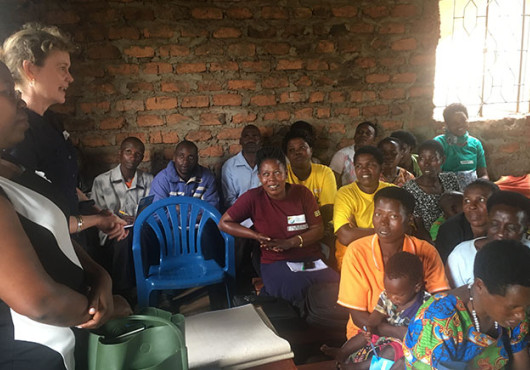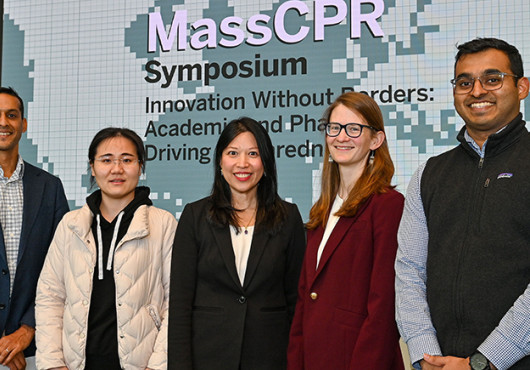
This article is part of Harvard Medical School’s continuing coverage of medicine, biomedical research, medical education and policy related to the SARS-CoV-2 pandemic and the disease COVID-19.
During a summer marked by public demonstrations in the U.S. calling attention to systemic racial injustice, Harvard Medical School global health leaders gathered online for a webinar to examine how to best achieve a more equitable and just health care system.
In June, the HMS Center for Primary Care and the Department of Global Health and Social Medicine in the Blavatnik Institute at HMS hosted a virtual conversation on the COVID-19 pandemic and the health equities the pandemic has exposed.
The conversation began by examining the evolving role of community health centers in responding to the pandemic, looking specifically at their role in serving communities of color which have been disproportionately affected by COVID-19.
Among the panelists was Claire-Cecile Pierre, instructor in global health and social medicine at HMS and chief medical officer of Harbor Health Services.
“Over 60 percent of the patients we serve are of a racial or ethnic minority. Right here in the U.S., we represent in some ways an extension of the public health system in a community-based approach,” said Pierre.
Community health centers, first established in the 1960s, are now present in every U.S. state, where they provide primary care to approximately 29 million people, regardless of their ability to pay. Designed to serve the most vulnerable populations, community health centers (CHCs) have been hit hard by the pandemic.
“As of May 29, a thousand of our sites had to close—and at a time when people knew their neighbors, understood the languages, and had built trust within community,” Pierre said.
This means the community health centers that remain open have to work even harder while the federal government prioritizes hospital care, she added.
“As CHCs that care for people who are most affected, the pandemic has impacted us emotionally. It has affected us financially, as we had to make really difficult decisions. We now realize that our very history of structural racism, that we were trying to combat,… 55 years later continues to be alive and something that we must continue to work on,” Pierre said.
Panelists went on to discuss community involvement in health care delivery, reflecting on the ways the pandemic has affected community engagement and opportunities for improvement.
“Community health centers across this country are on the front lines of this crisis, supporting those who’ve born a disproportionate risk, whether it’s the COVID-19 pandemic or other epidemics that cause premature death,” said Raj Panjabi, HMS assistant professor of medicine, part-time, at Brigham and Women’s Hospital and CEO of Last Mile Health.
The impact of community health centers extends beyond providing health care for the underserved and the financial gains are undeniable, he said.
Investment gains
“For every dollar invested in paying, supporting and integrating community health workers within the health care team, you see a $10 return. So it’s a 10 to one ROI [return of investment],” Panjabi said. “How does that happen? By increasing healthy life years, by helping to stop and respond to outbreaks, and by creating jobs in places where unemployment is very high.”
Randomized control trials have shown that community health workers improve health while reducing costly hospitalizations and readmissions. In fact, studies have shown that this can save Medicaid $4,200 per beneficiary. If scaled to just a quarter of U.S. Medicaid beneficiaries, community health workers would save taxpayers $78 billion annually.
Panjabi went on to describe the significance of community health care in the context of COVID-19, saying that poor and marginalized communities that are excluded from vaccines, testing and treatment tell the story of every pandemic in human history. A community-based approach to COVID-19 must start and stop inside communities, he added, and this can only be done through increased investment to fund more testing, contact tracing and treatment.
Despite ample medical literature touting the positive impact of primary care on population health and health costs, investments in primary care and the integration of primary care into the overall system have not risen to meet the field’s potential. In fact, the primary care sector is projected to lose $15 billion in 2020, threatening practice viability and diminishing the already insufficient number of providers in the United States, according to an HMS study.
Next steps
When asked about potential next steps for policymakers looking to build a more resilient, equitable health care system in response to the COVID-19, panelist and former Prime Minister of New Zealand Helen Clark recommended five concrete action items.
“Those who don’t learn the lessons of history are doomed to repeat them, and there are plenty of lessons coming out of this pandemic that policymakers need to be thinking about pretty urgently. The first one is to look after population health,” Clark said.
Explaining that universal health coverage and well-coordinated health systems are imperative in fighting the pandemic, Clark noted the disproportionately high death rates among those less privileged as a reprehensible outcome in dire need of attention from the U.S. health system.
She also touched on the value of a capitation system and a population-based payment system as examples of the many checks and balances providers need to support wellness and remain accountable.
“A health system planning for pandemics has to provide for essential service continuity, particularly in the poorest countries.” Clark said, noting that in many countries more people will die from indirect effects of the pandemic than from the disease itself.
“A way must be found to safely deliver continuity of services … without universal coverage and without a focus on equity, population health and good systems,” said Clark. “If we don’t address those things then we won’t have learned much.”
The right to health care
The conversation pivoted to the concept of a universal human right to health care and to the moral and economic argument for increased investment in primary health care.
“Equity has to be an absolute non-negotiable component,” said Donald Berwick, HMS lecturer on Health Care Policy, part-time, at HMS. “The color of your skin or the size of your wallet should not determine the care you get. Everyone ought to have care that works — the best care — there need to be no compromises with the quality of care. And everyone can help.”
Pierre honed in on the ‘how’ part of this approach.
“I would love to go back to these movements from the past around civil rights that helped galvanize the start of community health centers, which definitely brought us forward,” she said. “If we believe health care is a human right, and we believe there are new ways to deliver it,… how do we ask our policymakers to make a difference and use our creativity there?”
The right to health care should never be in question, panelists said, but they questioned how to find the resources to invest in primary health care in order to build a robust and effective health system. Surely, in the context of today, they said, as we confront pervasive systemic racism and a global pandemic, the economic argument for a system that’s based on whole-person care must be redundant.
“Money can always be found to fight a war, right? It can be found to fight a pandemic,” Clark said. “The case for primary health care as cost effective is extremely strong. So, I think you mount the arguments where they’ll find the most willing audience.”
Panjabi urged health sector leaders to adopt not just a moral and economic lens in advocating for primary health care but also a public narrative around security and safety.
“We’re just a lot less safe, all of us are. Not in a way where we think of exotic bodies as being diseased and now we’re afraid of them, but in a way where we are, in fact, in solidarity with each other,” Panjabi said.
“We can all wear a mask to support each other, for instance, during this COVID crisis. We all should be contributing to public pools of funding so that everyone can have vaccines when they’re available for COVID-19, and so that the poorest and the people of color and those more marginalized around the world and in rural communities, for instance, don’t get that vaccine last but get it at the same time that others get it,” he said.
David Duong, HMS instructor in medicine at Brigham and Women’s Hospital, called on each panelist to imagine the future of primary health care and elucidate necessary actions to arrive there.
Panelists reiterated the call for a moral commitment to improved, equitable health care via primary health care, but they debated how to get everyone on board with the moral argument so more effective care can be designed.
“I believe it’s a set of relationships, and a huge part of history, that we need to break. We need to get to the point where—just as when it’s time to invest in a war we go through algorithms to make those decisions—there should be a framework for making the argument for investing in health,” said Pierre, before delineating the significance of engaging all health care workers and patients in those moral arguments.
Panjabi highlighted the need to break down walls that confine minds, offices and clinics, saying that the vision ends with investing in the people closest to the problem, which is a basic fundamental value of primary health care.
“We cannot have a future of primary health care without investing in and ensuring that women, people of color and people from marginalized communities are part of the health care team,” he said. “Investment means employment. Investment means promotions. Investment means making them part of your leadership and so, to me, that is what a future of primary health care should and could look like if we start to act now.”
Berwick, who is president emeritus of the Institute for Healthcare Improvement and a former administrator of the U.S. Centers for Medicare and Medicaid Services, called for a shift of power to people and communities so that they are able to advocate for themselves for the type of care they need to thrive.
“I think we need to raise the moral vocabulary. It’s a set of moral commitments, and I think the countries that are able to clarify their moral intent will stand a better chance. And I think it can be done,” he said.
Finally, Berwick asked the health care community to unite to form a moral narrative.
“I have come to think that the health care community at large … should try to mobilize itself as a cogent political force, not for itself but for the people it serves. We haven’t seen that. The guilds are very well organized, but not the industry. All professionals. Together. Taking the banner for that moral imperative.”
For other articles and opportunities like this, subscribe to the HMS Center for Primary Care’s bi-weekly newsletter and visit the Program in Global Primary Care and Social Change website.
View the archived webinar, Reimagining Primary Healthcare - for all, by all.





